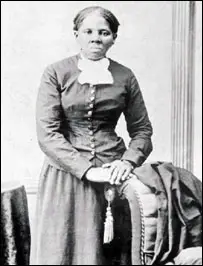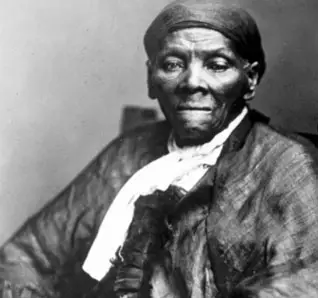Harriet Tubman

Perhaps one of the most amazing and inspirational figures to spring up not only in African American culture but in world terms is that of Harriet Tubman. She dedicated herself to the liberation and freedom of her people from the tyranny that was slavery, putting her own life on the line in order to do it. This is her unique story.
Early years
Her birth name was Araminta Ross and gained her a nickname of “Minty”. Her parents were Harriet Green and Ben Ross.
Harriet’s early years born into slavery were horrific. She was regularly beaten by her master, and on one occasion was left with a severe head wound, which was inflicted upon her when her master threw a heavy metal weight, intended to hit another slave (who ran away), and it caught her instead.
As a result of this injury, she suffered debilitating headaches, epileptic seizures and fits and regularly terrifying nightmares and “visions”. At the time, medical science was primitive and little was known about these conditions, so she put the visions down to “visitations by God”.
An early marriage
 In 1844, she met and married John Tubman. Not uncommonly for the time, the marriage was a “mixed” one, as he was a free man and she was still a slave. Marriages like this were not uncommon for the time, but they were complicated in nature because any children that came about because of the marriage would have to take the mother’s status as “slave” and would not be free like their father.
In 1844, she met and married John Tubman. Not uncommonly for the time, the marriage was a “mixed” one, as he was a free man and she was still a slave. Marriages like this were not uncommon for the time, but they were complicated in nature because any children that came about because of the marriage would have to take the mother’s status as “slave” and would not be free like their father.
John, as part of a plan to get his wife freed and as a means of back into the world of slavery at a later date, insisted on changing her name from Araminta to Harriet, possibly after her mother. He did this to ensure that not only she was made safe, but any future issue from the marriage and also her siblings.
However, in the year 1849 Harriet fell ill again, possibly still as a result of the earlier injury she’d sustained and as a result her value as a slave was greatly diminished, so she took it upon herself to try and break free from the slave plantation she “worked” at. John, her husband, refused to go with her as he felt it was too dangerous and the chances of her being recaptured were far too great. She took her brothers with her, but they also feared the risks and returned back to their enslaved lives.
The first of many trips
This escape from the plantation was the first of many. On this first trip she was given a piece of paper with the details of how to make her way to a safe house. On her way, for her own safety she was put into the back of a wagon and covered over with a sack. She eventually arrived in Pennsylvania, where she met a man called William Still who introduced her to the Philadelphia Ant-Slavery Society and the workings of the UGRR (Underground Rail Road).

Once she had familiarized herself with the system, she used it to begin to plan journeys to free slaves from plantations via its network. During the day, she took on odd jobs, washing, cooking and cleaning to be able to pay her way but all the time was planning missions whereby she could move back down to the deep south where she had come from, pick slaves up and covertly bring them back north to freedom. During this period she completed twenty missions. These feats of bravery led people to nickname her “Moses” and she was loved among all who she saved.
She managed to rescue her sister and a brother in 1850 and 1851, three elder brothers in the year 1854 and finally freed her parents three years later in 1857, all the while putting herself at great risk. All in all, she freed over three hundred slaves in total. An astonishing figure.
Her middle years and her autobiography
During the American Civil War of 1861-1865, she worked firstly for the US Army as a general cook, cleaner and nurse, tending to battle worn soldiers. Then she was employed as a spy behind the Confederate lines, again a brave and humbling thing to have done after having endured so many hardships. In the year 1862 she went to live in South Carolina where again, she helped many hundreds of Sea Islander slaves to their freedom.
“The Lord who told me to take care of my people meant me to do it for as long as I live and so I do what he told me to do”.
She was firmly and passionately of the belief that God had called her to help and it was her life’s destination.
The year 1869 was special for Harriet for a number of reasons. Firstly, it was the year in which she began to document her life for a biography written with the author Sarah Hopkins Bradford who had expressed a keen interest in her life. It was also the year she married her second husband Nelson Davis, a man who was significantly younger than her. The union lasted until his death some twenty years later from complications due to Tuberculosis.
Her last years
Right up until the dying embers of her life, Harriet never stopped campaigning. In the very late 1890s and well into her seventies she took up the cause of the suffragettes and felt passionately that women and women of color were just as entitled to vote as men.
It was during this time she made a purchase of a plot of land near her home and made plans for the African Methodist Church to take over both the land and her house. When she eventually became too ill and infirm to look after herself and was in a state of destitution, the women who she had campaigned with on the cause of suffragism paid her a monthly pension on $25 which kept her and was a means of protecting from repossession all her worldly goods.
No comments:
Post a Comment
Welcome! If you Like what you see, please comment, share thoughts and Visit our other Links! We will Love to see your comments here!!! Always write nice please! Thank you! Subscribe too please!!